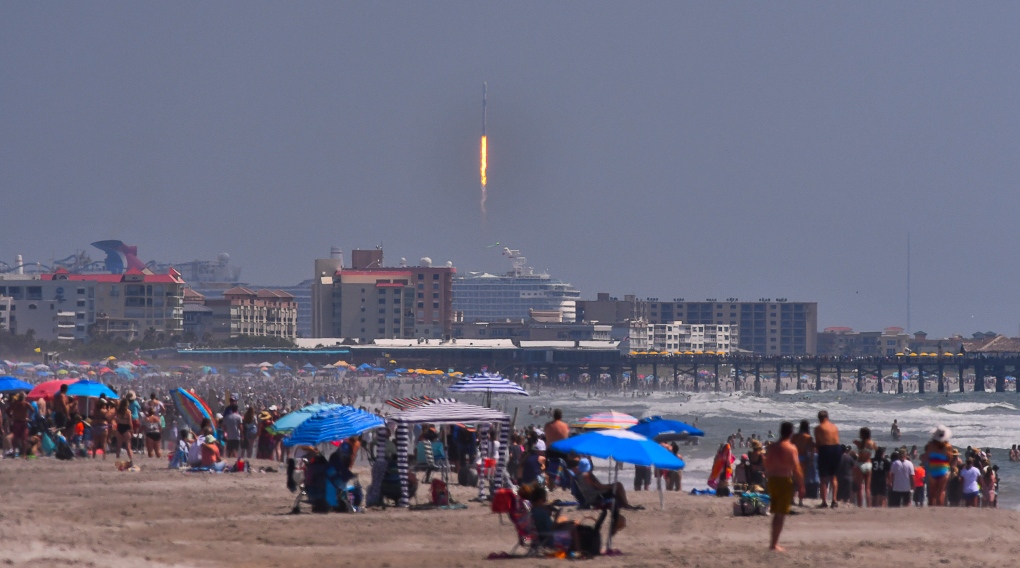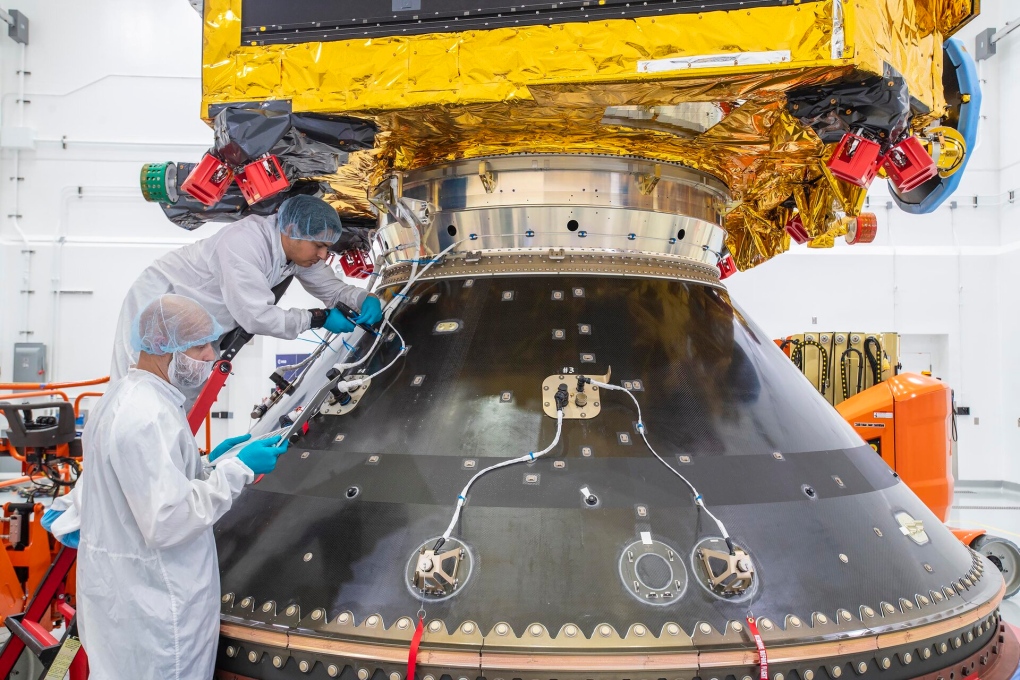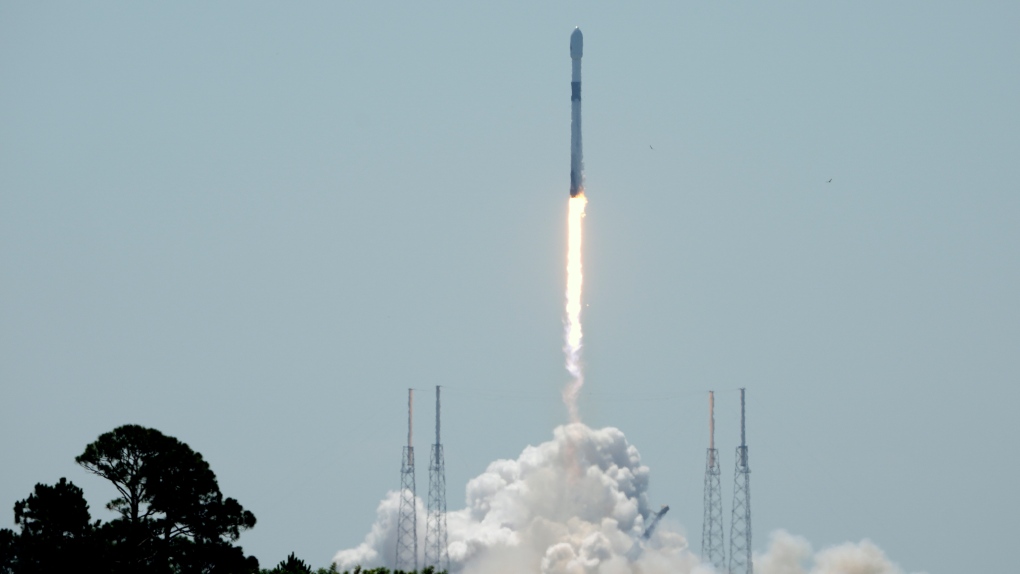New satellite on a mission to map cosmos and reveal secrets of dark matter
A team from the University of Waterloo are among scientists around the world celebrating the successful launch of a first-of-its-kind satellite.
Designed to answer some of the universe’s biggest mysteries, the European Space Agency’s Euclid space telescope took off Saturday from the Cape Canaveral Space Force Station in Florida.
“Watching it take off yesterday and you think ‘Yep, that’s our baby sitting up there on the top of the rocket,” says University of Waterloo professor Mike Hudson.
 Crowds on the beach in Cocoa Beach, Fla., watch the launch of a SpaceX Falcon 9 rocket for the European Space Agency with the Euclid space telescope on Saturday, July 1, 2023. The European space telescope blasted off from Cape Canaveral Space Force Station, Saturday on a quest to explore the mysterious and invisible realm known as the dark universe. (Malcolm Denemark/Florida Today via AP)
Crowds on the beach in Cocoa Beach, Fla., watch the launch of a SpaceX Falcon 9 rocket for the European Space Agency with the Euclid space telescope on Saturday, July 1, 2023. The European space telescope blasted off from Cape Canaveral Space Force Station, Saturday on a quest to explore the mysterious and invisible realm known as the dark universe. (Malcolm Denemark/Florida Today via AP)
Hudson and his University of Waterloo colleague Will Percival have been working on the project for over a decade.
In total, more than 2,000 scientists are involved, including four from the University of Waterloo.
WHAT IS THE EUCLID TELESCOPE DOING?
Euclid will spend more than six years in space creating a 3-D map of the cosmos.
The goal of the project is to better understand the properties of dark matter and why the universe continues to expand.
“[The expansion] is getting faster and this is just very difficult to explain. We don’t actually know what the answer is, we have some theories that could explain it and we call those theories ‘dark energy,” Percival says.
Hudson adds: “Is this dark energy some kind of mysterious energy? Or maybe the possibility that we don’t fully understand the laws of gravity?”
 This photo provided by the European Space Agency on June 29, 2023 shows the Euclid space telescope being prepared for launch from Cape Canaveral, Fla. (ESA via AP)
This photo provided by the European Space Agency on June 29, 2023 shows the Euclid space telescope being prepared for launch from Cape Canaveral, Fla. (ESA via AP)
NEW IMAGING TECHNOLOGY
What separates Euclid from its predecessors is its camera.
Scanning the sky, the technology is capable of taking 3-D images, allowing it map of billions of galaxies across more than a third of the sky.
“So you no longer have to just take your telescope and point at an object and say ‘I want an image of that object’. We get everything. There’s this opportunity to observe things that we don’t expect,” explains Percival.
 A SpaceX Falcon 9 rocket, with the European Space Agency Euclid space telescope, lifts off from pad 40 at the Cape Canaveral Space Force Station in Cape Canaveral, Fla., Saturday, July 1, 2023. The Euclid mission is designed to explore the evolution of the dark universe. (AP Photo/John Raoux)
A SpaceX Falcon 9 rocket, with the European Space Agency Euclid space telescope, lifts off from pad 40 at the Cape Canaveral Space Force Station in Cape Canaveral, Fla., Saturday, July 1, 2023. The Euclid mission is designed to explore the evolution of the dark universe. (AP Photo/John Raoux)
Euclid is expected to reach the point it will orbit around, 1.5 million kilometre from earth, in about a month.
Percival says the first batch of images could be relayed back to earth as early as the end of July.
“It’s a whole new territory and we’re mapping dark matter on scales that have never been done before,” Hudson says.
CTVNews.ca Top Stories

BREAKING Prime Minister Trudeau to meet Donald Trump at Mar-a-Lago
Prime Minister Justin Trudeau has landed in West Palm Beach, Fla., on Friday evening to meet with U.S.-president elect Donald Trump, sources confirm to CTV News.
'Mayday! Mayday! Mayday!': Details emerge in Boeing 737 incident at Montreal airport
New details suggest that there were communication issues between the pilots of a charter flight and the control tower at Montreal's Mirabel airport when a Boeing 737 made an emergency landing on Wednesday.
Hit man offered $100,000 to kill Montreal crime reporter covering his trial
Political leaders and press freedom groups on Friday were left shell-shocked after Montreal news outlet La Presse revealed that a hit man had offered $100,000 to have one of its crime reporters assassinated.
Cucumbers sold in Ontario, other provinces recalled over possible salmonella contamination
A U.S. company is recalling cucumbers sold in Ontario and other Canadian provinces due to possible salmonella contamination.
John Herdman resigns as head coach of Toronto FC
John Herdman, embroiled in the drone-spying scandal that has dogged Canada Soccer, has resigned as coach of Toronto FC.
Musk joins Trump and family for Thanksgiving at Mar-a-Lago
Elon Musk had a seat at the family table for Thanksgiving dinner at Mar-a-Lago, joining President-elect Donald Trump, Melania Trump and their 18-year-old son.
Billboard apologizes to Taylor Swift for video snafu
Billboard put together a video of some of Swift’s achievements and used a clip from Kanye West’s music video for the song “Famous.”
Trudeau says no question Trump is serious on tariff threat
Prime Minister Justin Trudeau says incoming U.S. president Donald Trump's threats on tariffs should be taken seriously.
In a shock offensive, insurgents breach Syria's largest city for the first time since 2016
Insurgents breached Syria's largest city Friday and clashed with government forces for the first time since 2016, according to a war monitor and fighters, in a surprise attack that sent residents fleeing and added fresh uncertainty to a region reeling from multiple wars.


































